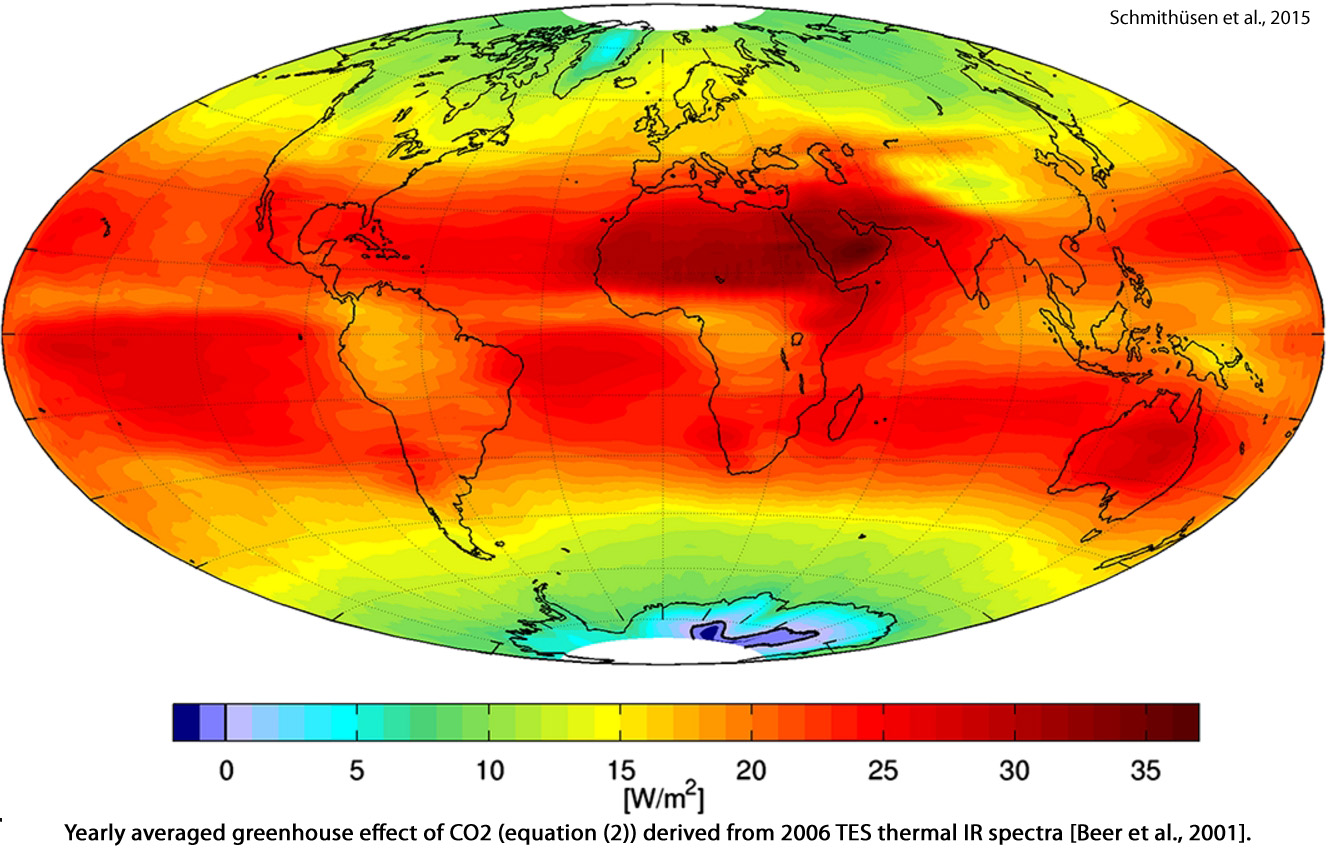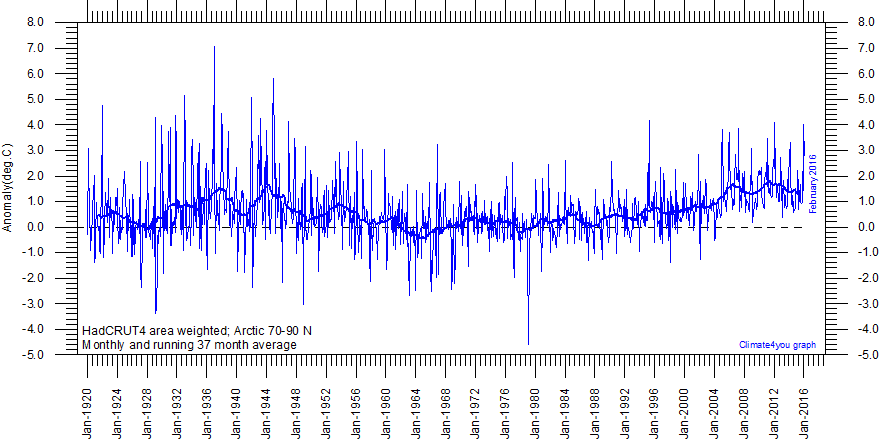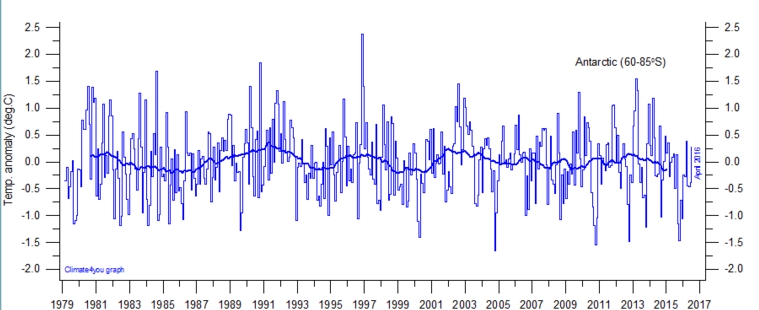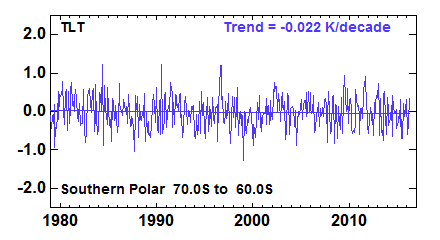By Kenneth Richard
We routinely read about “highest ever” Arctic ice sheet and sea ice melt rates in the Arctic. And about rapid, “faster-than-expected” melting of ice shelves in West Antarctica. And then, of course, we’re told that sea levels are rising at an accelerating rate — a catastrophically accelerating rate — due to the amplified warming at the poles, or “polar amplification”.
The predominant cause of these alarming climate changes is almost invariably attributed to anthropogenic CO2 emissions, of course. These headlines are now commonplace, designed to grab our attention and stir us to action. But does the scientific evidence confirm that the polar climate is predominantly determined by the rise in anthropogenic CO2 emissions?
A warming and cooling Arctic
As documented in the below Climate4you graph (HadCRUT4), the Arctic climate has followed a roughly 60-year oscillation in the last century. Arctic (70-90 N) temperatures warmed during the 1920s to 1940s, cooled during the 1950s to1990s, and then returned to a warming trend from the mid-1990s onward.
Source: Climate4You
Back in the early 1990s, the failure of the Arctic region to warm during the previous ~40 years (1950-1990) despite the concomitant increase in anthropogenic CO2 emissions was puzzling to scientists publishing in the journal Nature (Kahl et al., 1993: “Absence of evidence for greenhouse warming over the Arctic Ocean in the past 40 years“), leading them to question whether the models for the CO2 greenhouse warming hypothesis could adequately explain climate fluctuations for the polar regions.
Below are some excerpts from the Kahl et al. (1993) paper.
In particular, we do not observe the large surface warming trends predicted by models; indeed, we detect significant surface cooling trends over the western Arctic Ocean during winter and autumn. This discrepancy suggests that present climate models do not adequately incorporate the physical processes that affect the polar regions.
Conclusion Kahl et al., 1993:
The lack of widespread significant warming trends leads us to conclude that there is no strong evidence to support model simulations of greenhouse warming over the Arctic Ocean for the period 1950-1990. Our results, combined with the inconsistent performance of model simulations of Arctic climate indicate a need to understand better the physical processes that affect polar regions, especially atmosphere-ice-ocean interactions, ocean heat transfer and cloud radiative effects“
A cooling Antarctica, Southern Ocean since 1979
In contrast to the recent Arctic warming trend, there has been a lack of atmospheric warming in and around Antarctica since the late 1970s according to both the UAH and RSS datasets (as shown in the two graphs below). Scientists have documented a net growth in Antarctic sea ice in the last few decades, and, according to Fan et al. (2014), the Southern Ocean has also cooled since 1979, consistent with the increase in sea ice. These results are, of course, not consistent with modeled projections.
Key points from the Fan et al. (2014) paper entitled “Recent Antarctic sea ice trends in the context of Southern Ocean surface climate variations since 1950“:
[A]ll of these studies reported a close relationship between [sea ice extent] and sea surface temperature (SST) whereby sea ice gain is associated with lower SSTs and vice versa. … Cooling is evident over most of the Southern Ocean in all seasons and the annual mean, with magnitudes approximately 0.2–0.4°C per decade or 0.7–1.3°C over the 33 year period [1979-2011].”
Also RSS and UAH show Antarctic cooling since 1979:
UAH. Source: climate4you.
RSS. Source: here.
The unsettled science of polar amplification and CO2 forcing
As the warming in the Arctic has resumed (after decades of cooling), scientists no longer seem to be questioning the theoretical models projecting a polar-amplified warming due to increases in atmospheric CO2 concentrations. Instead, it is presumed to be “settled science” that the dominant cause of the Arctic warming trend since the mid-1990s has been anthropogenic CO2 emissions.
But is the science of polar amplification due to a rise in atmospheric CO2 really settled? A paper published recently (2015) by Dr. Schmithüsen (Helmholtz Centre for Polar and Marine Research, Bremerhaven, Germany) and colleagues may seriously undermine this conceptualization. The scientists analyze observational measurements (using the Tropospheric Emission Spectrometer) of global-scale CO2 radiative forcing and find the greenhouse warming effect for CO2 is “weak” (Greenland) to non-existent (Antarctica) at polar locations, and that the CO2 greenhouse warming effect is instead strongest in the equatorial regions. Not only is the polar amplification paradigm rendered questionable by these observed results, but Schmithüsen et al. (2015) have found that, for central Antarctica, increasing CO2 actually leads to a “negative greenhouse effect”, or a net cooling.
Below are highlighted excerpts from the Schmithüsen et al. (2015) paper entitled “How increasing CO2 leads to an increased negative greenhouse effect in Antarctica“.
For this region [central Antarctica], the emission to space is higher than the surface emission; and the greenhouse effect of CO2 is around zero or even negative, which has not been discussed so far. We investigated this in detail and show that for central Antarctica an increase in CO2 concentration leads to an increased long-wave energy loss to space, which cools the Earth-atmosphere system.”
And:
For most of the Antarctic Plateau, GHE-TES [greenhouse effect as measured by the Tropospheric Emission Spectrometer] is close to zero or even slightly negative; i.e., the presence of CO2 increases radiative cooling. Over Greenland, the greenhouse effect of CO2 is also comparatively weak but invariably positive. An evaluation of monthly averages of GHE-TES shows that the increased cooling due to CO2 of Antarctica is strongest during austral spring and autumn. … Central Antarctica is the only place on the planet where increased CO2 concentrations lead to an increased LW energy loss to space [cooling]. In the Northern Hemisphere the lowest, but invariably positive, [CO2] forcing values are seen over Greenland and Eastern Siberia.”
An excellent visual representation of the “weak” radiative forcing effect attributed to CO2 for the polar regions is found in Figure 4 (below) from the paper. Notice that, according to Tropospheric Emission Sperctrometer measurements, the radiative forcing values are in the range of only about -1 to +5 W/m2 for the polar ice sheets (Antarctica and Greenland), whereas radiative forcing values average roughly 20 W/m2 for the rest of the globe, with up to 35 W/m2 for the equatorial regions.

Source: here.
Cloud radiative forcing more than CO2 radiative forcing
To put this relatively “weak” -1 to +5 W/m2 CO2 greenhouse forcing for the polar regions into perspective, consider that the radiative forcing (greenhouse warming effect) for clouds has been found to be several times greater (~30 W/m2) over the Greenland ice sheet than for CO2 forcing (~5 W/m2). In fact, scientists (Tricht et al., 2016) have determined that cloud forcing warmed the Greenland climate by 1.2°C from 2007 to 2010, which is enough heat energy to melt 90 Gigatonnes (Gt) of ice.
Here’s an excerpt from the Tricht et al. (2016) paper “Clouds enhance Greenland ice sheet meltwater runoff“:
Clouds are known to play a pivotal role in regulating the local SEB [Surface Energy Balance], with competing warming and cooling effects on the surface. […] The satellite-based cloud observations allow to estimate the cloud impact on the SEB [Surface Energy Balance]. … The annual mean CRE [Cloud Radiative Effect] of 29.5 (±5.2) W m 2 provides enough energy to melt 90 Gt of ice in the GrIS [Greenland Ice Sheet] ablation area during July and August. … The snow model simulations, which capture the evolution of the GrIS SMB [Surface Mass Balance] from 2007 to 2010, indicate that clouds warm the GrIS [Greenland Ice Sheet] surface by 1.2° (±0.1) C on average over the entire period [2007-2010]. … These results further indicate that not only liquid-bearing clouds but also clouds composed exclusively of ice significantly increase radiative fluxes into the surface and decrease GrIS SMB [Greenland Ice Sheet Surface Mass Balance]”
Not only for Greenland, but on a global scale, cloud radiative forcing has also long been observed to be far more climatically influential than CO2 forcing. For example, in the Ramanathan et al. (1989) paper entitled “Cloud-Radiative Forcing and Climate: Results from the Earth Radiation Budget Experiment” — which has been cited over 1300 times in the peer-reviewed literature — it was determined that the greenhouse effect of CO2 may need to be increased by a factor of 100 to approach the greenhouse effect of clouds. What follows is an excerpt:
Water vapour and cloud are the dominant regulators of the radiative heating of the planet. ..The greenhouse effect of clouds may be larger than that resulting from a hundredfold increase in the CO2 concentration of the atmosphere. … The size of the observed net cloud forcing is about four times as large as the expected value of radiative forcing from a doubling of CO2. The shortwave and longwave components of cloud forcing are about ten times as large as those for a CO2 doubling.”
Summary
The implications of these measurements showing relatively minimal CO2 greenhouse forcing at the poles are enormous. Succinctly, the alarmist insistence of a significant anthropogenic influence on polar ice sheet melting and the consequent impact on sea level rise become highly dubious if observational evidence reveals that the CO2 greenhouse effect is only very modest (-1 to +5 W/m2) for the polar regions. For if the Arctic warming trend and sea ice decline that resumed in the 1990s cannot be significantly attributed to increases in atmospheric CO2, this severely undercuts the heart of alarming claims about humans catastrophically altering the polar — and global — climate.
The sensational headlines about melting polar ice and rapidly accelerating sea level rise would be reported with much less exhortative zeal if there wasn’t also a co-existing paradigm that says anthropogenic CO2 emissions are what drive these alleged climate changes. So when science doesn’t corroborate what the alarming headlines say about a significant anthropogenic or CO2 influence on the polar climate, ice melt, or sea level rise, that science is usually glossed over…or dismissed. After all, the science is supposed to be settled. Right?








Union of Concerned Scientists:
“[Global Warming] is expected to be more rapid and severe in polar regions compared to other places on Earth.”
http://www.ucsusa.org/global_warming/science_and_impacts/impacts/early-warning-signs-of-global-1.html#.V1IEkle8z0d
“Union of Concerned Scientists:”
Where’s Kenji when you need him 😉
“[Global Warming] is expected to be more rapid and severe in polar regions compared to other places on Earth.”
I guess they mean like in the Antarctic…
http://s19.postimg.org/hc7grx7lf/UAH_So_Pol_All.png
or even in the Arctic this century, before the big El Nino peak
http://s19.postimg.org/ys0o3bw6r/UAH_No_Pol_2000_El_Nino_spike.jpg
“… the CO2 greenhouse warming effect is instead strongest in the equatorial regions.”
Amazing! Why can’t any scientist publish a paper that explains the “heat trapping” effect of CO2 in the atmosphere. I can explain how this can’t possibly happen using standard radiative heat transfer rules.
You want a heat trapping gas? Consider nitrogen. It can be easily warmed by conduction from the surface. The claim is warmed gases rise and cool! Where did that energy go?
How is the atmosphere remaining cool enough at the tropopause to allow this warm rising gas to cool?
Only the triatomic molecules (H2O, CO2) interact with IR radiation. Below the tropopause, they mostly thermalize IR; above it, they mostly dethermalize (turn heat into IR, sending IR to space).
Increase in CO2 increases both effects (and has followup effects: like increasing convection due to changed lapse rate)
Okay, and how do these specified diatomic molecules effect the lapse rate?
Triatomic. If we look only at the effect of thermalization/dethermalization of IR, they should kink it, leading to the “hotspot” in the troposphere.
BUT this hotspot is not observed by weather balloons OR satellites (both agree that it’s not there) – it only exists in the models.
So – increased convection must compensate for it. And the models don’t get it right (never have, never will – as it would spell the end of the CO2AGW religion).
Richard,
CO2 does NOT affect the lapse rate in any measureable way (maybe slightly increases it, 4th or 5th decimal place stuff iirc)
H2O is a very different issue, because it can in exist in any or all of its 3 forms in the atmosphere.
In its vapour form it has a high specific heat and can carry a lot of latent energy.
The lapse rate is defined as the “acceleration due to gravity” / “specific heat of the substance”, so adding H2O can significantly effect the lapse rate.
As dry air has a specific heat of about 1, the “dry” lapse rate is about -9.8ºC/km. Humid air can have a specific heat of nearly twice that of dry air.. so a saturated lapse rate could be around -5º/km
disclaimer.. its been a while since I did that stuff.. so this is all.. “if my memory is correct”
Andy, basically agree with all you say. I am self taught on this subject via the internet. My studies tell me there is no such thing as a ‘greenhouse gas’. CO2 along with other atmospheric molecules gain heat energy from the surface by ‘conduction’; kinetic collisions. This is also happening anywhere up in the atmosphere. Thus any CO2 molecule will be at the local air temperature.
‘Translation’ will change the vibrational state of the CO2 molecule enabling it to RADIATE over its 13 to 17 micron band, yet the warmists claim it will absorb over this band. Even if it did, why should the CO2 absorb radiation only from the surface? What about all the other CO2 molecules all around it?
I could go on and on but I’ll stop here.
“Okay, and how do these specified diatomic (sic) molecules effect the lapse rate?” – Richard111
LAPSE RATE AND RELATED
http://motls.blogspot.com/2007/06/realclimate-saturated-confusion.html
http://motls.blogspot.com/2006/05/climate-sensitivity-and-editorial.html
http://motls.blogspot.com/2010/05/venus-chris-colose-vs-steve-goddard.html
http://motls.blogspot.com/2010/05/hyperventilating-on-venus.html
That should cover what the lapse rate is, what the warmists get wrong about it, and why we are not in any trouble from increasing CO2.
PS – the difference between “affect” and “effect”
http://grammarist.com/usage/affect-effect/
You might want to make a note of it.
From same Science page(Ramanathan article) is this link:
http://www.ncbi.nlm.nih.gov/pubmed/17370024 – Global warming 2007. An update to global warming: the balance of evidence and its policy implications.
There are many high impact, well-cited peer-reviewed articles supporting AGW – don’t ignore them
Well 2007 sure was a great year for the AGW lie. I liked the computer animated coastal city flood TV fraudumentaries. They don’t make’em like they used to.
In 2007 the IPCC didn’t simulate the QBO.
They still don’t.
You know. It’s not about improving their theory. Why would they? It’s unfalsifiable, as it predicts more rain, less rain, etc. It’s not a science.
And wasn’t it big fun?
BTW. Read about THE NOBLE LIE by Plato; the creation of a fraudulent religion to motivate the peasants to do as they’re told. It’s the manual for the CO2AGW cult.
Sorry, John but “many…articles supporting AGW” that are allegedly “high impact, well-cited [and] peer-reviewed” is what is called an “appeal to authority,” and is about as worthless as the garbage those articles contain.
“Don’t ignore them” you say? No thanks, I’ll pass.
Stop invoking childish logical fallacies to support your position. If you can’t do it from the facts, you’ve got nothing I’m interested in.
@John Macdonell
One e.g., of the garbage contained in that “high impact well-cited peer-reviewed” propaganda you linked to:
“The recent uproar over the so-called “hockey stick” temperature determination is much overblown since at least seven other groups have made relatively independent determinations of northern hemisphere temperatures over the same time period and derived essentially the same results”
WRONG!
The short answer
http://www.c3headlines.com/2012/03/the-infamous-hockey-stick-tree-scientists-michael-mann.html
The long view
http://www.john-daly.com/hockey/hockey.htm
So, right off the bat you give me unabashed lies to read, and you want me to trust anything else you say? The Hockey Stick wasn’t correct. It wasn’t a mistake. It was WILLFUL and DELIBERATE deception.
Better find a new name for that sock puppet. You sure wore that one out fast.
“In 2007 the IPCC didn’t simulate the QBO.
They still don’t.”
But they’re working on it:
https://www.ipcc.ch/publications_and_data/ar4/wg1/en/ch8s8-4-9.html
With all their work on climate models they haven’t achieved anything but failure. What then is your faith in them succeeding THIS time based on?
The lack of amplified Arctic warming is seen in records from weather stations around the Arctic circle.
https://rclutz.wordpress.com/2016/05/06/arctic-warming-unalarming/
UAH shows no Arctic warming in “NoPol” this century until the big El Nino spike.
http://s19.postimg.org/ys0o3bw6r/UAH_No_Pol_2000_El_Nino_spike.jpg
And the Antarctic is cooling slightly.
http://s19.postimg.org/hc7grx7lf/UAH_So_Pol_All.png
and the various eco-freak groups wants us to rject the sattlite data and only ecept their mindless banter about this so called Man Made Climate Change? Screw you Greenpeace
Dr. David Evans has 25 articles at sciencespeak under label climate-nd-solar. In these articles he accepts ALL the model theories and shows where the modelers made incorrect assumptions. If your beliefs is about AGW is religious, read these articles and see the light.
CC
http://www.skepticalscience.com/david-evans-understanding-goes-cold.html
It’s not possible to take these people seriously
http://www.breitbart.com/big-government/2015/07/24/you-dont-have-to-be-venal-weird-and-creepy-to-work-in-climate-science-but-it-certainly-helps/
Linking SkS prove you are brain-dean psychofant.
Oh my, what a wonderful and balanced source!
No-one as SkS has the vaguest idea what David Evans is even talking about. They are all just low-level grunts with basic level uni education, and an agenda to grind.
https://www.skepticalscience.com/team.php
Here is the SkepticalScience team – the people who write the articles. Notice how most of them have no Ph.D., much less any formal training in climate science. Below are a sampling of their “credentials”.
“I have worked in the financial sector as an actuary in insurance, reinsurance, supervision and life insurance”
“Rob is an environmentalist, scuba diver, spearfisherman, kayaker and former police officer.”
“a BSc in computer engineering.”
“a software developer with a lifelong interest in and love of science and teaching”
“Steve is studying part time for a Masters degree in Earth Science.”
“Rob’s claim to fame is being the founder of the popular pack and bag company Timbuk2.”
“a journalist who writes about climate change science and the ways it will affect us”
“Sveinn Atli lives in Iceland and is one of the two editors of loftslag.is”
“I have a MS in Organic Chemistry.”
“She has always had a lot of interest in environmental issues and has been active as a volunteer at the local zoo and a conservation group for many years.”
“a science student with Macquarie University, Sydney, intending to major in climate science.”
“Glenn studied Mechanical Engineering at Melbourne University.”
“studied modern languages and history in Switzerland before getting a Diploma in Environmental Policy”
“lives in The Netherlands and has a BS in software engineering”
“a senior lecturer in the School of Computing Sciences at the University of East Anglia”
“skeptical science” blog is run by activists, not scientists.
http://www.populartechnology.net/2013/05/97-study-falsely-classifies-scientists.html
Incompetent at best
https://notalotofpeopleknowthat.wordpress.com/2015/10/29/cooks-97-scam-debunked/
liars at worst
http://www.climatechangedispatch.com/skeptical-science-s-john-cook-making-up.html
Thank you for showing us, yet again, how useless your “ideas” are.